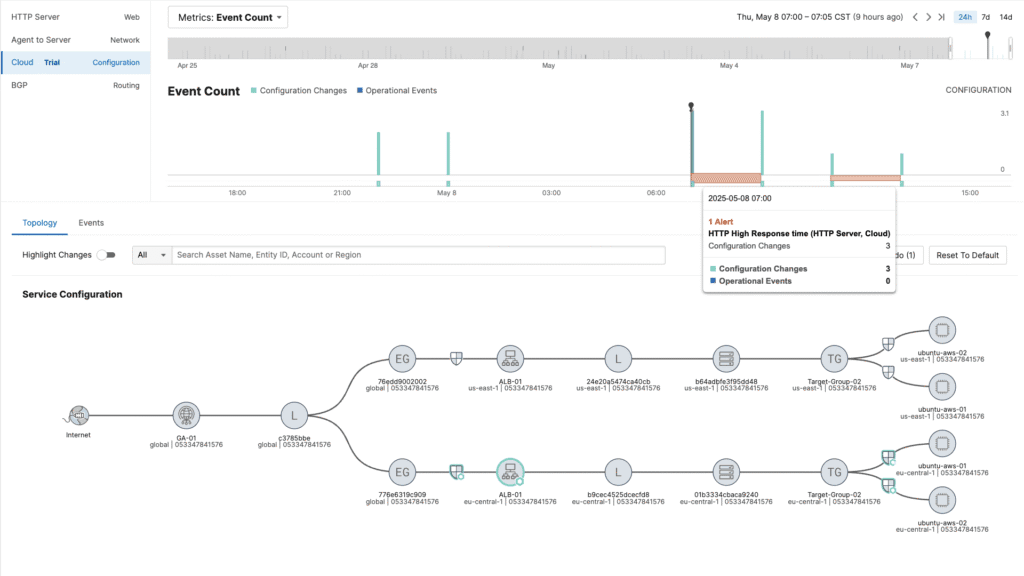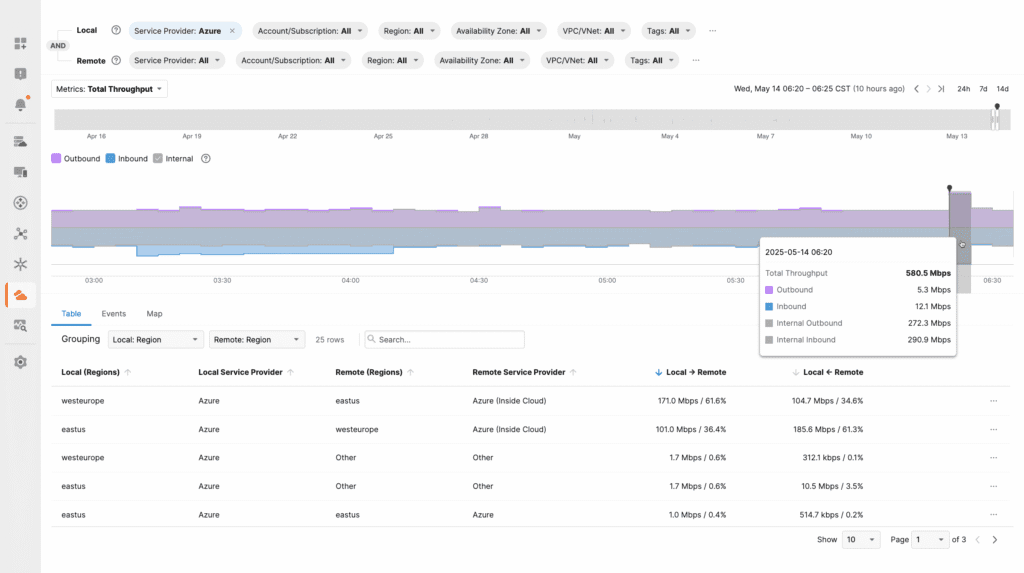Cloud Insights from Cisco ThousandEyes – bridging the cloud networking visibility gap
Update solution on August 5, 2025

In typical networks, there is the concept of network segmentation. With a well-defined IP scheme, you can look at an address and recognise that it’s in a particular data centre or if it’s a domain controller. In the cloud, traditional IP-based segmentation approaches are less effective due to their dynamic nature. Large cloud native networks are software defined, and IPs change a lot. Because IPs represent different things at different times, the key question must be revised to “What are these IPs at this time?” So, due to the shifting nature of the back end of the cloud environment, a team that is managing/visualising cloud is looking for contextual information such as, “How are applications directed to users and what networks users must transit to interact with those applications.”
Cloud Insights from ThousandEyes is a feature that extends network visibility into cloud infrastructure. For cloud environments like AWS and Azure, it correlates synthetic test results with cloud inventory, flow logs, and configuration events. This enables organisations to attribute network performance degradations to specific cloud infrastructure components and understand how cloud network conditions impact application delivery. Cloud Insights addresses the visibility gap, where traditional monitoring tools often fall short, in cloud environments. It tracks the status of cloud resources configuration by continuously collecting and comparing the configuration of cloud resources across time for cloud resources for providers such as Azure and AWS. This means that every change in the cloud setup, whether it’s a new deployment, a configuration update, or an operational status change, it gets captured and correlated with performance metrics such as network loss, latency or web application response time and availability. Cloud Insights delivers contextual visibility by mapping these metrics onto a visual representation of the cloud network topology. This way, you can see not only what happened but also where and determine why it might be happening. The same exercise can be done using flow log data. Flow log information enables you to determine the volume of traffic a resource, application, or service is receiving during the issue, identify the source of the increased traffic, and pinpoint the responsible IP addresses.
Customers wishing to use Cloud Insights provide a role or service principal to ThousandEyes, and the Cloud Insights service will then automatically inventory their cloud resources and visualise them as a dynamic topology map. This inventory evolves as your architecture changes. The solution automatically creates and maintains a dynamic inventory of all cloud resources, providing an always-current snapshot of what is running in your environment and their operational and configuration status. Cloud Insights provides full-featured integration with AWS, including automatic inventory and VPC flow logs, while expanding its multi-cloud capabilities. This inventory evolves as your architecture changes. The solution automatically creates and maintains a dynamic inventory of all cloud resources, providing an always-current snapshot of what is running in your environment. This map not only shows what components are active but also how they interact, making it easier for operations teams to monitor dependencies and potential single points of failure.
One of the key features of Cloud Insights is the ability to correlate performance issues with cloud configuration changes. Because you’re dealing with a ‘shifting target’ challenge, where traditional IP signifiers aren’t effective, Cloud Insights correlates Azure VNET flow logs, AWS VPC flow logs, and configuration state from AWS and Azure with test metrics to give the necessary context on where an activity is taking place and what is happening. For example, if a sudden spike in latency coincides with a recent update in a cloud service, Cloud Insights can highlight this correlation, helping engineers quickly zero in on the root cause.
Cloud Insights provides further insights into hybrid connectivity for services such as AWS Direct Connect and Azure Express Route. This provides value to Cloud Network teams responsible for maintaining availability across these links for traffic between on-prem locations and the Cloud. Today’s troubleshooting capabilities of such links relies on manual execution of traces, whereas Cloud Insights offers continuous monitoring of the performance across these links, across different layers and correlating with multiple network and application metrics.
Since about 2018 Bloor has been investigating and reporting on the visibility gap that exists for IT infrastructure and operations (I&O) teams tasked with delivering assured end-to-end visibility for business applications in the Cloud. Terms like Full Stack Observability (FSO) and Observability into Cloud environments can be misleading. The reality is, that when you step through the door into a Hyperscalers network, you will find it
very difficult to monitor the passage of data traversing
the network.
Cloud Insights’ ability to collect and correlate cloud-centric telemetry data with network and application metrics end-to-end sets it apart from traditional monitoring solutions that cannot easily access the rich infrastructure data available from cloud environments and connect it to a comprehensive set of metrics across layers and domains. Cloud Insights ability to contrast and correlate several domains from the point of observation all the way into the cloud. This capability enable teams to understand the complexities of the modern, hybrid, and multi-cloud ecosystem at the infrastructure and network topology level. This is a critical capability that enhances collaboration by providing a unifying view of service delivery chains and dependency mapping for Cloud Ops, Sec Ops and NetOps teams.
By providing continuous monitoring and automatic alerting, Cloud Insights ensures that your IT teams can rapidly detect and respond to issues before they escalate into end-user-impacting problems.
Cloud Insights from ThousandEyes is a vital solution for any organisation that relies on cloud services from AWS and Azure. Its ability to dynamically monitor, visualise, and correlate cloud configurations with network performance translates into faster incident resolution, optimised cloud operations, and – most importantly – an enhanced digital experience for users.
At the moment the service is available on AWS and Azure, but work is on-going to provide the same capabilities for GCP. This is scheduled to be available in the coming months and will turn Cloud Insights from a valuable monitoring and management solution in your AWS and Azure environments, into a critical component of any multi-cloud monitoring and management strategy moving forward.
Figure 1 – Service Impacting Configuration Changes

Figure 2 – Azure VNet Flow Logs

“This ability to correlate both manual and automatic changes to impact between our AWS applications in a single pane of glass has dramatically reduced our time to resolution and improved our operational efficiency.”
Chris Ojeda, Associate Engineer,
Site Reliability,
Royal Caribbean Group
Related Company
Connect with Us
Ready to Get Started
Learn how Bloor Research can support your organization’s journey toward a smarter, more secure future."
Connect with us Join Our Community
